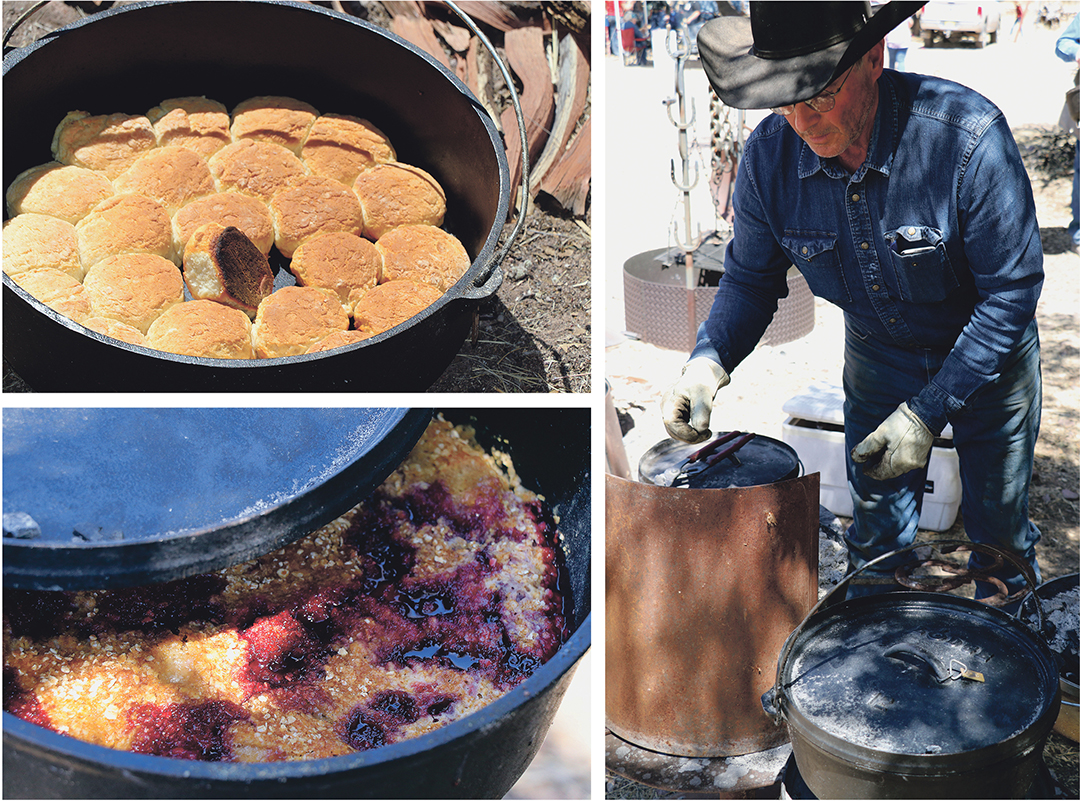
“I probably have seventy-five pieces of cast iron at home,” Todd Hensley tells me. Not one to pass up campfire-cooked chile, I have a ticket in my pocket for the red chile chicken sliders, peach cobbler, and biscuits he is busily preparing. He’s standing at the helm of four well-seasoned dutch ovens, each lined up waist high on stands not far from his pickup truck, as a group of his friends—his pit crew, let’s say—watch him work his magic from their folding chairs beneath a nearby tree, on call for when he might need a hand.
I take in the mingling smells from the various camps of woodsmoke and buttery biscuits, chile and venison tips, baked apples and bread pudding. The light breeze moves through the budding trees and flutters the American flags hanging above a few of the camps. Meals are served at 2 pm, still a few hours away, and my stomach rumbles.
Hensley has a disarming smile, a salt-and-pepper mullet, and a holster for both cell phone and knife hanging beside his camo cargos. He explains that he likes to cook with cast irons at his home in Las Cruces to avoid heating his home too much with the kitchen stove, and has been cooking with dutch ovens for the past two decades. He regularly takes them on his hunting trips, and it seems he can cook pretty much anything in them. “I’ve done dove teriyaki pizza in a dutch oven before,” he says casually. “Everyone wants to go hunting with me,” he adds with a smile. I’m hardly surprised, especially after a peek at his peach cobbler beneath a cast-iron lid.
By all accounts, it’s a record–breaking crowd for the Annual Glenwood Dutch Oven Gathering. “This is our biggest year,” Molly Bryan, an avid mule rider and one of the event’s co-organizers, tells me a few minutes later as I peruse the camps of cooks at the bustling Glenwood Community Park. She estimates about three hundred people in the crowd as she looks out over the flames of the campfire where her Frito pie, a tequila dessert, and biscuits cook.
Throughout the park, kids play; older people sit in the covered pavilion catching up; various venders hawk home-baked goods, hand-knapped knives, and jars of home-canned pickles and salsas; and the thirteen camps of dutch oven cooks—the main attraction—busily tend to their campfires and prized cast irons. Glenwood, population thirty-four, nestled in a valley at the western edge of the Gila National Forest beside the San Francisco River, doesn’t get crowds like this too often.
I walk the grounds and learn from various camp chefs about the family history of some of the cast irons (a few had in been in the family for generations, and one could be traced to the last cattle drive to reach the “end of the Driveway” at Magdalena), hear tales about past winning entries of venison stews and green chile, and steal glimpses of mouthwatering dishes as chefs remove the heavy lids with pliers to make sure all is going to plan.
One camp chef, Steve Topmiller, uses welded plow discs as cooking platforms—a homemade setup with a barebones sculptural beauty—and explains that part of the art behind cooking campfire biscuits is to maintain the entire dutch oven at 350 degrees. To achieve this temperature, Topmiller multiplies the diameter of the dutch oven (in inches) by two-thirds, and uses that number of coals to heat the dish. “Most of the heat is top down, but a little on the bottom,” he says, pointing out with his pliers how the majority of gray coals rest on the closed lid of his dutch oven. “Look around the edges for brown and you know the bottom’s done.” At that point, he instructs, take the dutch oven off the bottom coals and cook only with top heat until finished. He offers me a taste of a fresh batch of warm and golden biscuits that are crispy, airy, and light.

This scene of campfire cast-iron cookware, a technology developed in China going back at least to the second-century Han dynasty and that became widespread in Europe by the sixteenth century, unmistakably evokes iconic images of chuckwagon dinners that once fed far-from-home cattle workers in the American West. Yet what strikes me at this Glenwood event is less a sense of overt nostalgia for bygone days and more the spirit of camaraderie and community gathering. It’s a spirit of sharing slow-cooked, soul-satisfying food with enough time to take in the smells, build a healthy appetite, and swap some stories; and it’s not a spirit of making a profit (meals are just ten dollars), or posing for carefully crafted, self-conscious photos on Instagram, or winning a fierce contest. As one of the co-organizers emphasized to me during my rounds of the campgrounds, “It’s not a competition, it’s a gathering.”
When I return to Hensley’s camp promptly at two, I find that a line of hungry diners has formed. When it’s my turn, he loads my plate and recommends an extra cup of the smoky red chile to dip the biscuits in, which unsurprisingly turns out to be an expert recommendation. The entire meal is deeply satisfying, and the cobbler, with its crispy, slightly smoky, and caramelized crust, steals the show. It’s not a competition, but, nonetheless, every bite is a winner.

If you go . . .
Camping at the Cosmic Campground is a great call, especially if the moon is new and the clouds are few. It’s a perfect place to study the cosmos, take in the rolling hills, and, fire restrictions permitting, try your own hand at campfire cuisine.
The Glenwood Trading Post is the only option in downtown Glenwood for gas and staples. They have an impressive rock collection for the rock hounders among us, and also sell huge propane-fired discos for backcountry cooking in case you forgot yours at home.

Willy Carleton
Willy Carletonis the former co-editor of edible New Mexico and The Bite. He is the author of Fruit, Fiber, and Fire: A History of Modern Agriculture in New Mexico, which explores the cultural and environmental history of apples, cotton, and chiles in our region.


